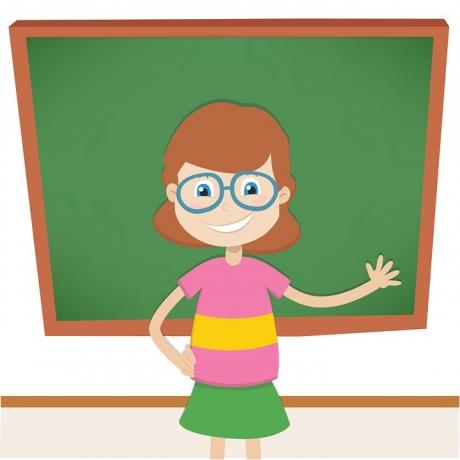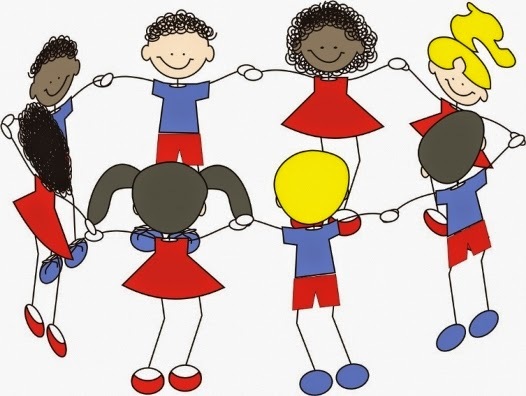
Check this post for some suggestions for Play and Dynamics for the first day of class.
We know that the academy trains us, but professionalization we only acquire with practice, who never asked. “What will I do with the students on the first day of class?” It is a common question and whoever enters the teaching profession will end up going through it.
Below we will give some tips for how the teacher's presentation should be for the first day of class and how students should be presented at the beginning of the school year according to their age and school level. Know more: What to do on the first day of class?
See excellent suggestions playful and fun for all ages of dynamic for the first day of class – Icebreaker activities:
Index
This super booklet with 50 dynamics and games Classroom Fun are great resources for all students to participate in your lesson.
See an example of the games and dynamics you will find in this booklet, and then check out the link for the PDF download:
Goals: This is a very creative way to find out the level of knowledge of people, in relation to a certain subject or theme.
Material: prepare questions in advance on a sheet of paper for participants to answer. Roll each sheet, one after the other, so that they look like a “cabbage”.
Procedures: Form a circle, and start to pass the "cabbage".
Put on some well-paced music and keep your back to the group. Stopping the music, whoever has the “cabbage” in his hand should remove the first sheet, read and respond.
If you don't know, the group can help and so on until all the questions are answered, whoever gets the last question is the winner.
Note: Educator adapts this dynamic according to the level of knowledge of its students, not forgetting that we have different levels in our classrooms, so use questions related to knowledge areas, in Portuguese for example work with syllables, sentences etc…
Also use mathematical calculations etc...
_____
To access the complete material in PDF, check out the following link and download:
It is important to know the group you are going to work with and it is also good for them to get to know each other. This dynamic makes everyone talk a little about themselves without getting that boring and dragging thing, like a TV interview.
Distribute colored candies or jelly beans to the students (2 or 3 each) and ask them to leave them on the desk. Then specify the colors (which you can specify according to what you want to know about your students). For example, in a small class – 15 students, for example – and in the 10 to 14 age group, do more or less the following:
Call each student and he will choose one of the two or three colors he has to talk about. If you choose the red one, for example, it will talk about leisure.
After each person speaks, you can ask the group if they want to ask anything else related to what the student was talking about. It is interesting to ask, if the student says he has a brother, ask if he is older or younger, if the relationship is good, etc. If you say you have a dog, ask the name, if you know how to be cute, if you have quirks, etc.
If they are older students, you can change the criteria, add others like love life, professional life, religion, etc... That's up to you.
This dynamic with classes that are starting because it helps to keep the names of the students (very important) and also both I and the class in general get to know a little more about them.
Of course, after the dynamic ends, authorize to eat the candies.
This dynamic shows that the people know well who is on the side, our knowledge is very limited and restricted to the environment we are in.
See too: Children's Games and Dynamics
This dynamic is very useful to know what the students like and the that they do outside of school to make the class more interesting and also objectively show how to use in your daily life what are they learning.
Give each student a piece of paper where they will have to write in it 3 sentences about themselves, one of which it will be false. But they shouldn't write obvious things like ‘I have green eyes’ and yes things that friends would know about him, like 'I've been to Japan', for example.
Ask them to put their name and write the 3 sentences (and of course I'll save these papers for later use when preparing the classes), then they hand them all to me. Choose a paper at random and read the first sentence, asking whose it is. The class makes its guesses and I instruct students that when they identified what they wrote disguise and also say they think it's So-and-so.
Write down the name of the person most of the class found in front of the sentence. who was the owner and I choose another role. Continue reading the first few sentences of each one, then I start to read the second and finally the third sentence, always noting in front of the sentence who the class thought it was.
At the end, everyone is already anxious, read the sentence and say: this one they thought it was from So-and-so, actually it's from Sicrana. and make some questions about the sentence to the student. Do this until you finish and then ask students what they thought of the game.

Introduce yourself to the students and get to know them too, leading them to interact with the group.
Paper and pen
Note: This dynamic is for when students know each other and only the teacher is a novice.
As the teacher does not know the students, he can also interview them.
Duration: 20 to 30 minutes
Age group: From 8 years
This dynamic is intended to collect information about your students as soon as classes start and can also be used to “break the ice” in groups that still they had no contact, because recognizing likes and habits similar to yours students or participants will feel more comfortable.
Open a word document and insert a table with the number of columns equal to 1 and the number of lines corresponding to the number of participants
of the joke.In each row of the table put a question, you can use the suggested ones at the end of this post or any other information you want to get from your students on the first day.Print and cut into strips, then fold into a very small square. Buy candies of various flavors and put them in a bag or box where they will not be able to see the content. Tape one question to each bullet.
With students in a circle, present the bag or box to the first student at the your left. He should pick up a bullet and read the question aloud to
the whole class and then answer it. You can add some candies with different words, if you want too give away some souvenirs that first day. See below some suggestions of questions.
Describe your family. / Do you have a pet? Talk about him. / What are your favorite TV shows? / what kind of music Do you like? Talk about it. / Who is your best friend and why do you consider it so? / What is your favorite movie genre?
What do you do on the weekend? / What is your hobby? / you collect
something? / How often do you use the internet? / What do you do in your
free time during the week? / Do you practice any sports? Talk about it.
Which subject do you like the most? / In which subject do you have the most difficulty? / What is the lowest grade you ever got? Why do you think this happened? / Have you cheated on the test yet? Tell us how it went. / You do your homework on time. If not, why? / What will you study when you finish high school? / What kind of profession will you choose?
You can use your creativity, and if you are a language teacher these questions may be in the language being taught. You can also use this play for an oral review before a history, geography test, sciences, etc. It's up to your imagination to adapt this activity, and then can share the result with us.
See also:
Promoting integration between students and professors, strengthens students' communication and interpersonal relationships.

A small object, such as a ball.
Tips: Observe which students are paying attention and are able to remember the information your colleague spoke. If anyone has difficulty, ask other students to help.
Point out the importance of knowing how to listen, that we are often very concerned about what we are going to say, that we forget to pay attention to what is said to us.
Duration: 15 to 20 minutes
Age group: all ages
It's great for the first day of class, promotes student interaction, gives us precious information about students (which we'll use in the preparation of classes, inserting the material in your reality) and can be an interesting tool to promote certain behaviors.
Put some suggestions for personal questions on the board, such as:
age
what do you do besides school
what do you want to do in the future
hobby
favorite sport
And everything else you want to know or find important in the first class. Give the ball of string to a student, say that you will have to hold the end of the string and throw the ball to the student to ask questions.
The student holds the end of the ball (which he keeps in his hand at all times) and throws it to the second student, asks the questions suggested and then the student who answered holds the part of the string and throws the ball to the next student, who should do the same.
At the end, there will be a huge “web”, the students laugh a lot, have fun and sometimes they have to help so that the ball reaches the student who will answer the questions.
In language classes the questions can be in the language taught and will serve as a review.
After the game, with the web already assembled, ask the students:
Would it be easy to make this web without the help of others?
Was everyone's help needed to graduate?
Is collaboration necessary to build something?
Does knowing more about others also promote a “connection” between people?
To what extent do we care about the other person at the other end of the string?
What can we say to this person?
What connections do I have with this person other than string?
What do we have in common?
You can also ask (for more mature students) what they thought of the game and what it suggests to them.
This dynamic is interesting because it makes students talk and discover things about the colleagues, while promoting movement, your students will not be apathetic and sleepy after her.

Divide students into 2 or 3 groups depending on the number of students in the class. It is interesting that groups have between 7 and 10 elements each. Name the groups: blue, yellow, green. Ask them to line up, each group lines up in front of you.
With your list in hand, tell them they have 3 minutes to organize themselves in ascending order of age. At the end of the 3 minutes, whistle. After the whistle, students can no longer change places. Check which group is most right, including by months (11 years and 2 months, 11 years and 3 months, etc). Then tell them they have 3 minutes to organize themselves alphabetically by first name. You can add multiple items to your list. Who has more siblings, from the tallest to the shortest, inverse alphabetical order of surname… your imagination is the limit. The group that completes the most tasks without making mistakes, or the one that makes less mistakes, wins.
It is important to move the desks away for this game, and thus prevent them from getting hurt. Let them mess around as they organize. Depending on the age and knowledge of your students you can include various tasks (month of birth, number of siblings, more vowels in the name, etc.).
In order to make students get to know each other better.
A sheet containing the form below:
Duration: 20 to 30 minutes
Age group: From 10 years old
If you liked the post Dynamics for the first day of school – Play back to school, be sure to share with your friends on social media. We also recommend this other link with 201 Fun dynamics for the classroom.
After completing the activities, make a conversation with the students and talk about teamwork, union... How was it possible to put the pen in the bottle?
___________

Each student will receive a candy;
The child cannot bend either arm to eat this bonbon (Arms outstretched);
The child will only be able to eat the bonbon when offering it to a colleague.
Note: The child cannot eat his own bonbon.
Let the kids think and rack their brains for a long time until they figure out a way to use the union.
_____
it is Dynamics for the first day of class, it is wonderful to work empathy and respect with students.
__________

This dynamic is for the children to realize that even with the same instruction, no drawing came out the same, everyone is different.
Thus, the teacher will be able to work on respect for individuality and respect for difference.
Subscribe to our email list and receive interesting information and updates in your email inbox
Thanks for signing up.


